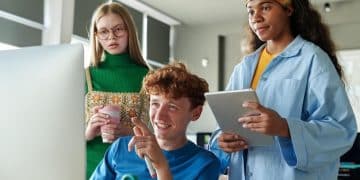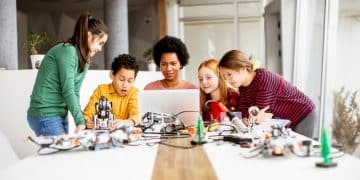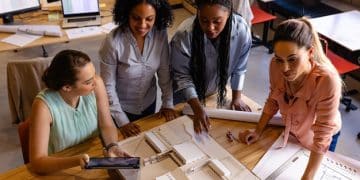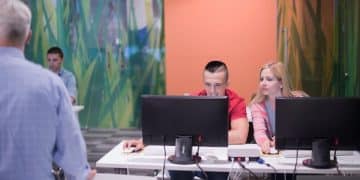Social Media in Education: Benefits, Challenges, and Strategies
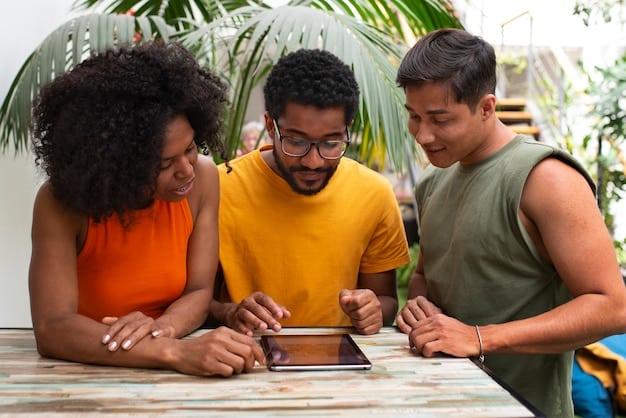
The Impact of Social Media on Education: Navigating the Challenges and Opportunities is a complex issue involving both potential benefits for learning and significant challenges related to distraction, misinformation, and cyberbullying that educators and students must address.
The pervasive nature of social media has undeniably reshaped numerous aspects of modern life, and education is no exception. The Impact of Social Media on Education: Navigating the Challenges and Opportunities presents a multifaceted landscape that educators and students alike must understand and adapt to.
The Evolving Role of Social Media in Education
Social media’s influence on education is constantly evolving, presenting both exciting possibilities and significant hurdles. It has transitioned from being a mere distraction in the classroom to a powerful tool for communication, collaboration, and learning.
Enhancing Communication
One of the primary ways social media impacts education is by enhancing communication between students, teachers, and parents. Platforms like Twitter, Facebook, and dedicated educational apps facilitate instant messaging, group discussions, and announcements.
Facilitating Collaboration
Social media also fosters collaboration among students. Online groups and forums allow students to work together on projects, share resources, and provide peer support, irrespective of their physical location or schedule.
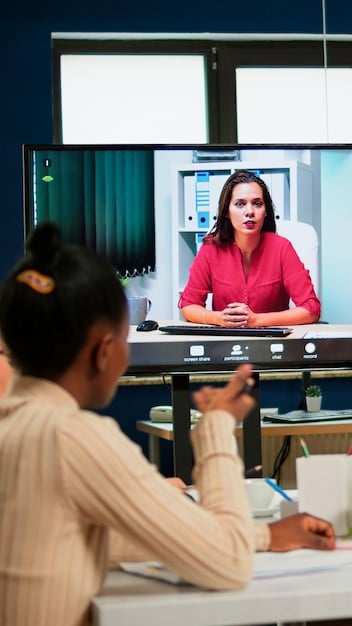
Key advantages include:
- Improved communication between students, teachers, and parents.
- Enhanced collaboration on projects and assignments.
- Access to a broader range of perspectives and information.
- Increased student engagement and motivation.
In conclusion, the evolving role of social media in education is marked by its ability to enhance communication and facilitate collaboration, ultimately transforming the learning environment.
Benefits of Social Media in the Classroom
When used effectively, social media can bring numerous benefits to the classroom. It extends the learning environment beyond the physical confines of the school and offers opportunities for personalized and engaging instruction.
Access to Information
Social media platforms provide students with access to a wealth of information and resources that may not be readily available in textbooks or traditional learning materials. Students can quickly research topics, access expert opinions, and stay updated on current events.
Personalized Learning Experiences
Social media enables personalized learning experiences by allowing students to explore their interests and learn at their own pace. Educators can curate content and resources that cater to individual learning styles and preferences.

Key benefits include:
- Increased access to information and diverse perspectives.
- Personalized learning experiences tailored to individual needs.
- Enhanced student engagement and motivation through interactive content.
- Development of critical thinking and digital literacy skills.
In summary, social media offers significant benefits in the classroom by increasing access to information and enabling personalized learning experiences, ultimately enhancing student engagement and skills development.
Challenges and Risks of Social Media in Education
Despite its numerous advantages, social media also presents challenges and risks that educators and students must address. These include issues related to distraction, misinformation, cyberbullying, and privacy.
Distraction and Reduced Attention Spans
One of the primary challenges is the potential for distraction. Social media can divert students’ attention from learning activities, leading to reduced focus and decreased academic performance.
Misinformation and Fake News
The spread of misinformation and fake news on social media is another significant concern. Students need to develop critical thinking skills to evaluate the credibility of online sources and avoid being misled by false information.
Cyberbullying and Online Harassment
Cyberbullying and online harassment are serious issues that can have a detrimental impact on students’ mental health and well-being. Educators need to promote responsible online behavior and provide support for students who experience cyberbullying.
Key challenges and risks include:
- Increased distraction and reduced attention spans among students.
- The spread of misinformation and fake news.
- Cyberbullying and online harassment.
- Privacy concerns and data security risks.
In conclusion, while social media offers many benefits, it also poses significant challenges and risks related to distraction, misinformation, and cyberbullying, requiring proactive measures to protect students.
Strategies for Responsible Social Media Use in Schools
To mitigate the risks associated with social media, schools need to implement strategies for responsible use. This includes developing clear policies, providing digital literacy training, and promoting a culture of respect and responsibility online.
Developing Clear Social Media Policies
Schools should develop clear social media policies that outline acceptable behavior, consequences for violations, and guidelines for privacy and data security. These policies should be communicated to students, teachers, and parents.
Providing Digital Literacy Training
Digital literacy training is essential for helping students develop the skills they need to navigate social media safely and responsibly. This includes teaching students how to evaluate the credibility of online sources, protect their privacy, and avoid cyberbullying.
Effective strategies include:
- Developing clear and comprehensive social media policies.
- Providing digital literacy training for students, teachers, and parents.
- Promoting a culture of respect and responsibility online.
- Monitoring social media activity and addressing incidents of cyberbullying or harassment.
In summary, responsible use of social media in schools requires clear policies, digital literacy training, and a culture of respect, creating a safer and more productive learning environment.
Case Studies: Successful Integration of Social Media in Education
Several schools and educators have successfully integrated social media into their teaching practices. These case studies offer valuable insights into how social media can be used to enhance learning outcomes and promote student engagement.
Example 1: Using Twitter for Class Discussions
One school uses Twitter to facilitate class discussions and debates. Students are required to tweet their thoughts and opinions on a particular topic using a designated hashtag. This allows students to engage in discussions outside of class time and provides a platform for shy students to express their views.
Example 2: Creating a Class Blog
Another teacher created a class blog where students can publish their writing and creative work. The blog serves as a platform for students to showcase their talents, receive feedback from their peers, and develop their digital writing skills.
Key takeaways from successful integrations include:
- Using social media to facilitate class discussions and debates.
- Creating class blogs or websites for students to showcase their work.
- Leveraging social media for project-based learning and collaborative assignments.
- Connecting with experts and professionals in the field.
In conclusion, case studies demonstrate that successful integration of social media in education requires careful planning, clear objectives, and a focus on enhancing learning outcomes.
The Future of Social Media in Education
As social media continues to evolve, its role in education is likely to expand and transform. Emerging technologies such as virtual reality (VR) and augmented reality (AR) could further enhance the learning experience and create new opportunities for engagement and collaboration.
The Potential of VR and AR
VR and AR technologies have the potential to revolutionize education by creating immersive and interactive learning environments. Students can take virtual field trips, conduct virtual experiments, and collaborate with peers in virtual spaces.
The Importance of Adaptive Learning Platforms
Adaptive learning platforms use data analytics and artificial intelligence to personalize learning experiences and provide students with tailored support. These platforms can track student progress, identify areas of weakness, and adjust the curriculum accordingly.
| Key Element | Brief Description |
|---|---|
| 💬 Communication | Enhances interaction between students, teachers, and parents. |
| 📚 Information Access | Provides access to diverse perspectives and learning materials. |
| ⚠️ Challenges | Includes distraction, misinformation, and cyberbullying risks. |
| 🛡️ Strategies | Involves policy development and digital literacy training. |
Frequently Asked Questions
▼
Social media facilitates instant messaging, group discussions, and announcements between students, teachers, and parents, improving information flow and engagement.
▼
The main challenges include distraction, the spread of misinformation, cyberbullying, and concerns regarding privacy and data security.
▼
Schools can develop clear social media policies, provide digital literacy training, promote a culture of respect, and monitor online activity to address incidents of cyberbullying.
▼
Educators can curate content tailored to individual learning styles, allowing students to explore their interests and learn at their own pace, enhancing engagement.
▼
The future involves integrating virtual reality (VR) and augmented reality (AR) for immersive learning and using adaptive platforms for personalized support and curriculum adjustments.
Conclusion
In conclusion, the impact of social media on education: navigating the challenges and opportunities requires a balanced approach, harnessing its benefits while mitigating its risks through policy, training, and responsible usage to create a more effective and engaging learning environment.
